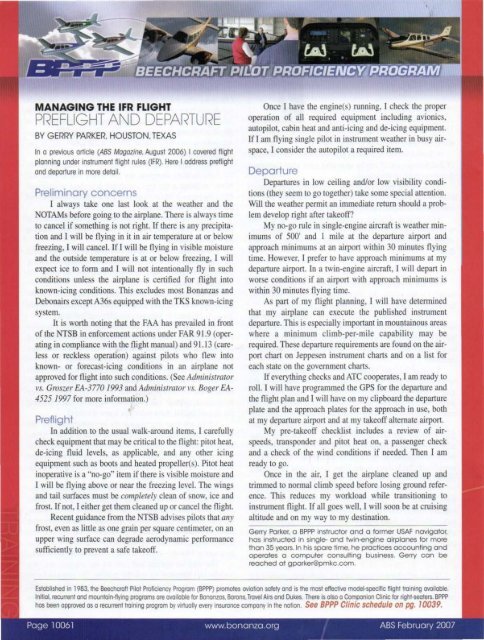February 2007 - American Bonanza Society
February 2007 - American Bonanza Society
February 2007 - American Bonanza Society
Create successful ePaper yourself
Turn your PDF publications into a flip-book with our unique Google optimized e-Paper software.
MANAGING THE IFR FLIGHTPREFLIGHT AND DEPARTUREBY GERRY PARKER, HOUSTON, TEXASIn a previous article (ABS Magazine, August 2006) I covered flightplanning under instrument ftight rules (IFR). Here I address preflightand departure in more detail.Preliminary concernsI always take one last look at the weather and theNOTAMs before going to the airplane. There is always timeto cancel if something is not right. If there is any precipitationand I will be flying in it in air temperature at or belowfreezing, [ will cancel. If I will be flying in visible moistureand the outside temperature is at or below freezing, I willexpect ice to form and I will not intentionally fly in suchconditions unless the airplane is certified for flight intoknown-icing conditions. This excludes most <strong>Bonanza</strong>s andDebonairs except A36s equipped with the TKS known-icingsystem.It is worth noting that the FAA has prevailed in frontof the NTSB in enforcement actions under FAR 91.9 (operatingin compliance with the flight manual) and 91.13 (carelessor reckless operation) against pilots who flew intoknown- or forecast-icing conditions in an airplane notapproved for flight into such conditions. (See AdlllinistralOrvs. Groszer EA-3770 1993 and Administrator vs. Boger EA-45251997 for more information.),PreflightIn addition to the usual walk-around items, I carefullycheck equipment that may be critical to the flight: pitot heat,de-icing fluid levels, as applicable, and any other icingequipment such as boots and heated propeller(s). Pitot heatinoperative is a "no-go" item if there is visible moisture andI will be flying above or near the freezing level. The wingsand tail surfaces must be completely clean of snow, ice andfrost. If not, I either get them cleaned up or cancel the flight.Recent guidance from the NTSB advises pilots that anyfrost, even as little as one grain per square centimeter, on anupper wing surface can degrade aerodynamic performancesufficiently to prevent a safe takeoff.Once I have the engine(s) running, I check the properoperation of all required equipment including avionics,autopilot, cabin heat and anti-icing and de-icing equipment.If I am flying single pilot in instrument weather in busy airspace,I consider the autopilot a required item.DepartureDepartures in low ceiling andlor low visibility conditions(they seem to go together) take some special attention.Will the weather permit an immediate return should a problemdevelop right after takeoff!My no-go rule in single-engine aircraft is weather minimumsof 500' and I mile at the departure airport andapproach minimums at an airport within 30 minutes flyingtime. However, I prefer to have approach minimums at mydeparture airport. [n a twin-engine aircraft, I will depart inworse conditions if an airport with approach minimums iswithin 30 minutes flying time.As part of my flight planning, J will have determinedthat my airplane can execute the published instrumentdeparture. This is especially important in mountainous areaswhere a minimum c1imb-per-mile capability may berequired. These departure requirements are found on the airportchart on Jeppesen instrument charts and on a list foreach state on the govemment charts.If everything checks and ATC cooperates, I am ready toroll. I will have programmed the GPS for the departure andthe flight plan and I will have on my clipboard the departureplate and the approach plates for the approach in use, bothat my departure airport and at my takeoff alternate airport.My pre-takeoff checklist includes a review of airspeeds,transponder and pitot heat on, a passenger checkand a check of the wind conditions if needed. Then I amready to go.Once in the air, I get the airplane cleaned up andtrimmed to normal climb speed before losing ground reference.This reduces my workload while transitioning toinstrument flight. If all goes well, I will soon be at cruisingaltitude and on my way to my destination.Gerry Porker, a BPPP instructor and a former USAF navigator,has instructed in single- and twin~ngine airplanes for morethan 35 years. In his spore time, he practices accounting andoperates a computer consulting business. Gerry can bereached at gparker@pmkc.com.Established in 1983. the BeechcroH Pilot ProfiCiency Program (BPPP) promotes aviation safety and is the most effective model-specific flight training available.Initial. recurrent and mountain·flying programs are available for <strong>Bonanza</strong>s. Barons. Trovel Airs and Dukes. There is also a Companion Clinic for right·seaters. BPPPhas been approved as a recurrent training program by virtually every insurance company in the notion. See BPPP Clinic schedule on pg. 10039.

















